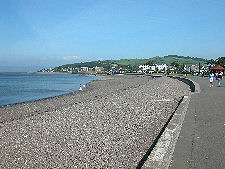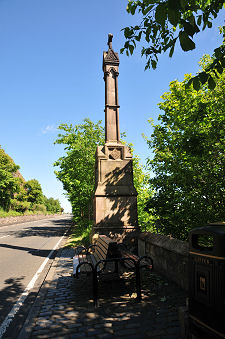 Looking West from Kinghorn Towards the Cliffs Where Alexander III Died |
Alexander III lived from 4 September 1241 to 19 March 1286 and was King of Scotland from 6 July 1249 to 19 March 1286. He was the only son of Alexander II, and came to the throne on the death of his father, aged just 8. He was crowned on 13 July 1249 at Scone Abbey. The wider picture in Scotland at the time is set out in our Historical Timeline.
Alexander's period of minority rule was marked by conflict between rival Scottish factions keen to exert power in his name. Among the Guardians ruling in his name was Clement of Dunblane. Meanwhile, Henry III of England was hovering in the background, hoping to take advantage of the circumstances. On Christmas Day 1251, aged 10, Alexander III was knighted by Henry III at York. The following day he married the English monarch's eldest daughter, Princess Margaret.
Despite his lack of years, Alexander evaded his new father-in-law's efforts to make him swear homage to the English King for the Kingdom of Scotland. Meanwhile the rivalry within Scotland for control of Alexander continued, and included his being kidnapped at one point.
Alexander took control of the crown in his own right on attaining the age of 21 in 1262. He immediately turned his focus to completing the project left unfinished by his father Alexander II's death, regaining the Western Isles from Norwegian control.
Alexander III's challenges to the rule of the Norwegians culminated with a large fleet of longships under King Håkon IV of Norway and the Isle of Man sailing into the Firth of Clyde in 1263.
Most of September 1263 was spent in negotiations between Alexander and Håkon: the latter growing ever more impatient, the former playing for time and hoping for the onset of bad weather. This duly arrived in the form of a fierce storm on the night of 30 September 1263 which sank some of Håkon's ships and drove a number of others ashore at Largs.
What has since become know as "The Battle of Largs" was really no more than a series of largely inconclusive skirmishes. But although his forces probably still outnumbered the Scots, in the face of a demoralised and mutinous fleet, Håkon had little choice but to sail for home. He never reached it, dying in the Bishop's Palace in Kirkwall, Orkney, en route. With him died the Norse claim over the Western Isles. Under the Treaty of Perth in 1266, Håkon's successor ceded the Isle of Man and the Western Isles to Scotland in return for the payment of 4000 marks (a mark was an accounting unit roughly equal to two-thirds of an English pound or one-and-a-half Scottish pounds). The full story is set out in The Norwegian Account of Haco's Expedition Against Scotland; 1263.
Margaret died in 1274 and their two sons had both died by early 1283. Their daughter, also called Margaret, was the wife of King Eirik II of Norway and died in childbirth. In 1284 the child, who had survived, and who was also called Margaret (the Maid of Norway), was recognised by the Scottish Parliament as the heir presumptive to the Scottish throne.
Alexander wanted a male heir, so he married again. This time it was to Yolande de Dreux, Comtesse de Montfort, daughter of Robert IV, Comte de Dreux. They married on 14 October 1285. Five months later, tragedy struck. On 19 March 1286, King Alexander III, then aged 44, was returning on horseback to be with Yolande at Kinghorn Castle after meeting his Council in Edinburgh. It was after dark and the weather was very bad when he came along the cliff road above Pettycur. It is believed Alexander's horse stumbled, and pitched him to his death over the cliffs.
Alexander's death brought to an end a golden age in Scottish History and resulted in a crisis of succession that led directly to the Wars of Independence with England. But for his decision to take that path that night, none of us would ever have heard of William Wallace, Robert the Bruce or Bannockburn: and today's Scotland could be an utterly different place. Alexander was succeeded by Margaret, Maid of Norway.


